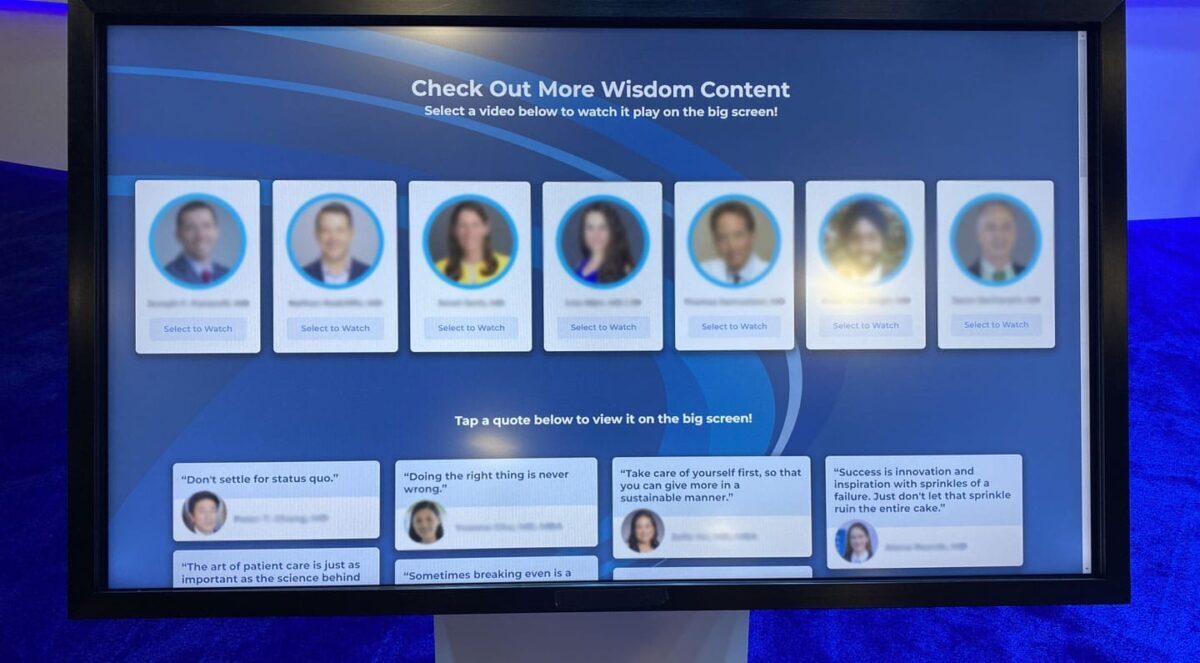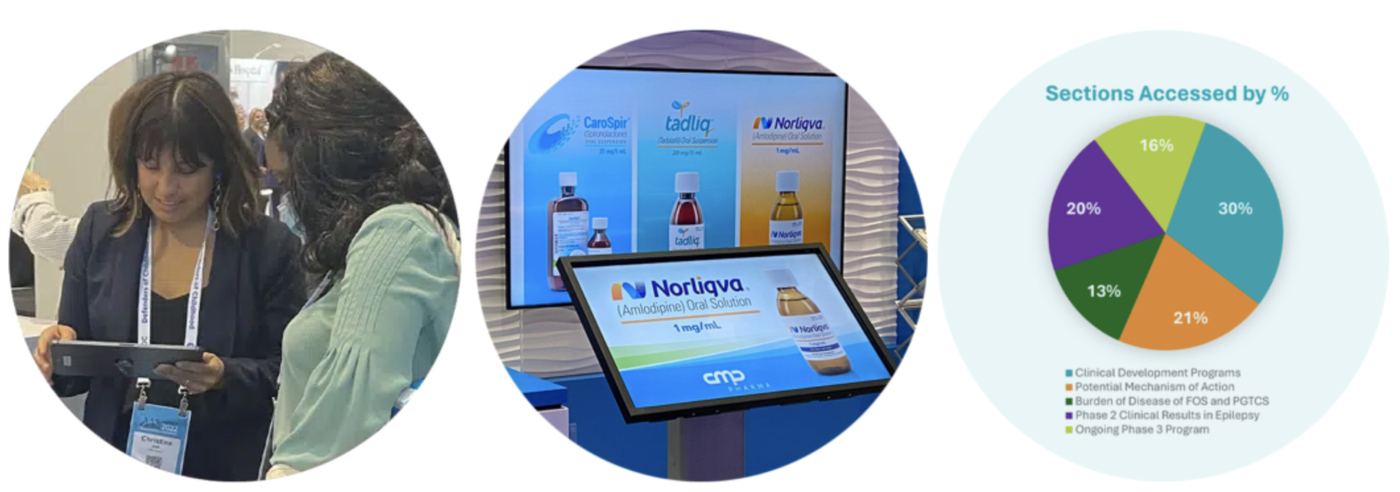Your team had a productive couple of days at a tradeshow, talking with many prospects who stopped by the booth. The investment in attending the event will definitely pay big dividends. Or will it?

Yes, tradeshows are one of the best ways for companies in the healthcare industry to engage with prospects and guide them into a sales funnel toward becoming customers. However, you’ve got to be able to track the success of your efforts for a couple of reasons. First, the people signing off on tradeshow expenditures will want to know that the events are producing results. Simply saying that your team was “very busy” or that the booth “got lots of traffic” isn’t enough.
Second, capturing and analyzing key tradeshow metrics is essential for fine-tuning your show presence. That includes everything from the traffic flow through your booth to the amount of time spent in different booth areas and how well different content types are resonating with visitors. Here again, informal observations might be interesting, but they aren’t actionable.
That’s why systematically collecting and assessing data is essential—but not just any data. The best analytics are the ones focused on your company’s goals.
Unfortunately, two mistakes are common in business, including with healthcare companies. Larger organizations often have processes in place to analyze metrics, but they aren’t always capturing and assessing the metrics that matter. Smaller companies frequently haven’t implemented any processes at all.
The good news is that businesses that choose to start capturing and using metrics or decide to enhance their existing processes can enjoy significant benefits from their efforts.

Capturing Performance Metrics at Healthcare Tradeshows: Understanding What’s Allowable
One reason some healthcare companies are hesitant about collecting metrics is the necessary but complex web of data privacy regulations governing the industry. Can we ask this? Are we allowed to record that? Rather than wrestle with those questions and risk violating rules, many organizations capture little or no data. Better safe than sorry, the thinking goes.
That’s understandable but unfortunate. A benefit of working with Slate360 is that we’re solely focused on healthcare and have a deep understanding of the data collection restrictions. Our knowledge is no substitute for a company seeking legal advice on any practices they have concerns about or any regulations they feel are ambiguous, but our guidance provides a solid foundation from which to work.
KPIs You Should Measure at Every Healthcare Tradeshow
Key performance indicators. Lead capture. Performance metrics. Whatever you call the information or the processes for capturing it, assessing the benefits of exhibiting at tradeshows is essential.
But what data should you collect? There are dozens of metrics that could have value, but most companies don’t have the capacity (or desire) to capture and measure them all.
Every healthcare organization has different offerings and unique sales and marketing goals. Consequently, there’s no universally applicable set of data points to capture. However, every business can benefit from measuring some or all of the following:
1. Booth traffic
This is a simple metric, but one you shouldn’t ignore. Especially when considered across multiple shows, it can help you start to understand the impact of booth positioning on the show floor, the content you offer, in-booth experiences, etc.
2. Qualified leads
The key here is “qualified.” Someone who provides their contact information might be a qualified lead, or they might just be looking to chat with someone while they wait for a colleague. So, it’s crucial to define what makes a lead qualified. For instance, setting an appointment for a post-show conversation might be one way to earn that label.
3. Beyond-the-booth digital engagement
Not all tradeshow metrics can be captured in your booth. Sometimes, visitors come and go quickly without much interaction with your team but, soon after, they visit your website or engage on your social media channels. So, it’s critical to have a broad perspective of “performance metrics.” It’s also essential to understand your web traffic and social media engagement baselines so you can identify show-generated spikes.
4. Other exposure opportunities
Critical data can and should also be collected at events like scientific poster sessions and interactive presentations that take place away from a company’s tradeshow booth. The same applies to information captured in the booth with quizzes and other interactive tools. Needless to say, leads are valuable, whether generated in or outside of your booth.
5. Press coverage
Some tradeshows let you submit a press kit. They then record how many outlets requested it. You can also assess press coverage in other ways, like noting booth visits from media members or searching for online mentions.
6. Brand awareness
“Awareness” is notoriously hard to measure, but actions like conducting surveys before and after a show can help you determine if the event created more of it.
7. Dwell time
This metric can be viewed in different ways. The most straightforward assessment is the average time people stayed in the booth. However, motion tracking and other technology can help you detect how long people tend to dwell in specific booth areas or participate in interactive experiences. It’s also crucial to measure dwell time on particular content. For example, if the average viewing time of one item is 10 minutes and another is 12 seconds, you know what is resonating and where to focus future content development efforts.
8. Catering consumption
People sometimes scoff at recording the number of cups of coffee served or cupcakes consumed. However, those figures can be enlightening, especially when technology like QR codes is implemented to capture data from those interactions.

Increasing Show ROI and Enhancing Your Presence
As noted previously, there are many other tradeshow metrics you can capture or calculate from the data you gather. But if you’re carefully recording some or all of the above, you’ll have data you can leverage to demonstrate ROI. What’s more, you’ll be able to enhance your booth and offerings to ensure that number rises steadily.
Figures like conversion rate, cost per lead, customer acquisition cost, and others are easier to capture or derive once you have processes in place for collecting metrics consistently.
How We Help Clients Leverage Data to Their Advantage
When it comes to tradeshow data collection and assessment, customization is essential. Gathering information without a plan or purpose for it isn’t helpful, and it might even have a negative impact if it drains your resources without delivering any benefit.
At Slate360, we collaborate with clients to understand their tradeshow challenges and opportunities. Based on those insights, our team works with theirs to develop a plan covering what data to capture, how to collect it, and what to do with it. The last of those elements is essential, as many companies—even those doing an excellent job of tracking metrics—fall short when it comes to following up on leads and keeping conversations started at shows moving forward.
Contact Slate360 today and let’s talk about the data you need to support your tradeshow strategy and hit your marketing and sales targets.
About Slate360
Our team of seasoned healthcare industry pros crafts unique, immersive exhibit experiences that attract attendees and create lasting impressions of clients and their offerings. We work as an extension of a client’s team to streamline strategy development, execution, and analytics and to ensure an onsite or virtual trade show presence furthers their marketing objectives. https://slate360inc.com/
Slate360 Media Contact
Pam Laferriere, 657-204-1916
Source: Prodigy.press
Release ID: 1321403
